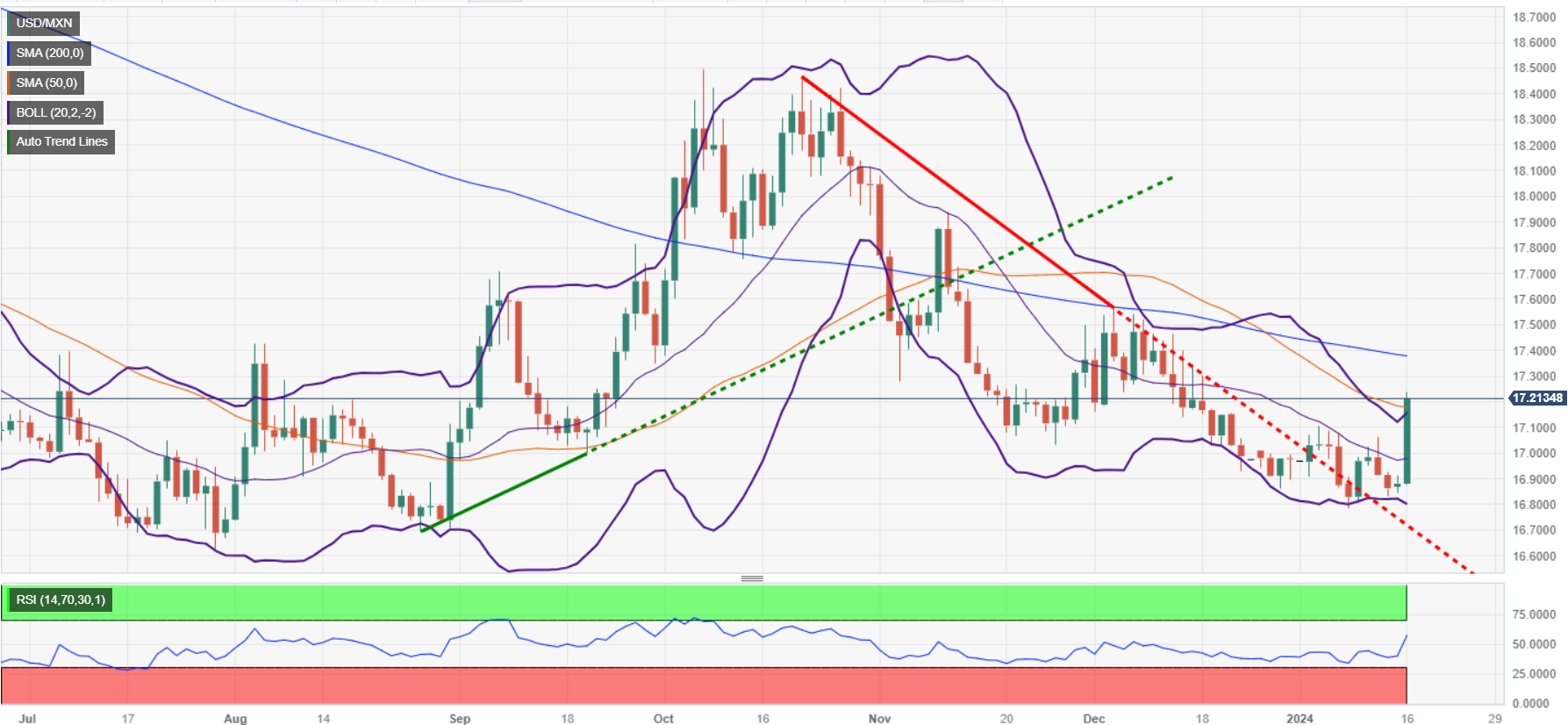- Mexican Peso drops for a second consecutive day, falling 2% against a robust US Dollar buoyed by risk aversion and a less dovish Fed outlook.
- USD/MXN pair approaches the critical 50-day SMA as risk aversion hits Wall Street in exchange for US Dollar safety.
- Fed Governor Waller's latest remarks hint at the possibility of easing monetary policy, though it would be slower than investors’ expectations.
The Mexican Peso posts back-to-back days with losses and plummets sharply against the US Dollar (USD), which benefits from risk aversion, and traders pricing in a less dovish Federal Reserve (Fed), according to Chicago Board of Trade (CBOT) data. That, alongside a jump in US Treasury bond yields, has sponsored the USD/MXN with a substantial leg up, trading at 17.21 or 2% higher.
Market sentiment remained sour on Tuesday as Wall Street resumed trading and began a short week in the red as market participants came back from a holiday. Traders in the futures market trimmed bets that the Fed would cut rates aggressively, spurring a jump in US Treasury bond yields, which are bolstering the Greenback as the US Dollar Index (DXY) rose 0.60% to 103.29. Consequently, the USD/MXN pair edged toward the 50-day Simple Moving Average (SMA) near 17.18, with buyers threatening to reclaim that level, posing their eyes on the confluence of the 100 and 200-day SMAs.
In the meantime, Fed Governor Christopher Waller is crossing the newswires, saying that data could “allow” the Fed to consider easing monetary policy.
Daily digest market movers: Mexican Peso tumbles as Fed’s Waller supports cuts if inflation stays low
- Fed’s Waller added that policy could be adjusted as long as inflation doesn’t rebound or stay high and emphasized the Fed could cut rates by 75 basis points in 2024. He added rate cuts should be made methodically, adding that there’s no reason to cut as quickly as in the past.
- The New York Fed Empire State Manufacturing Index for January declined to -43.7 compared to estimates of -5 and a December reading of -14.5. This sharp slump raises concerns about the potential for a recovery in the manufacturing sector. Furthermore, in the latest month, the ISM Manufacturing PMI continued to indicate a contraction in the sector, marking 14 consecutive months of contractionary readings.
- Mexico’s economic data released in January shows the economy is encountering several challenges. Inflation in the country increased from 4.32% to 4.66% YoY in December, surpassing the projected figure of 4.55%. Additionally, the same report showed that while underlying inflation is trending downward toward 5%, it remains elevated. This persistent high level of underlying inflation could potentially discourage officials at Banxico (the Central Bank of Mexico) from implementing an easing of monetary policy in the first quarter of 2024.
- In addition to that, Industrial Production plunged -1.0% MoM after achieving eight months of expansion, indicating that higher interest rates set by Banxico at 11.25% are beginning to impact the economy.
- In that regard, Auto Production for December slumped from 18.1% to -9.9% YoY.
- Confidence surveys released on January 3 and 8 showed that business confidence remained high at 54.6, bolstered by “nearshoring” prospects. However, consumers have begun to turn pessimistic as they expect inflation and economic deceleration to weigh on their economies.
- The week’s Mexican economic docket will feature Retail Sales for November, expected to remain unchanged at 3.4% YoY, according to the consensus.
- Although December’s meeting minutes from Banxico (the Central Bank of Mexico) suggest that the central bank might contemplate easing its monetary policy, the inflation report for December could hinder any move toward policy relaxation.
- Analysts at Standard Chartered noted, “We expect the policy rate to be lowered to 9.25% by end-2024, although an official downward revision in the output gap could open the door for more aggressive rate cuts.”
- On January 5, a Reuters poll suggested the Mexican Peso could weaken 5.4% to 18.00 per US Dollar in the 12 months following December.
Technical analysis: Mexican Peso slumps sharply as USD/MXN climbs toward 17.15
The USD/MXN has shifted to a neutral bias as buyers lifted the exchange rate past the 17.00 figure, opening the door to challenge the 50-day SMA at 17.18. A breach of the latter would expose the confluence of the 200 and 100-day SMAs at around 17.38/17.40. Further upside is seen at December’s high of 17.56, followed by the May 23 high of 17.99.
On the contrary, if bears drag prices below 17.00, that could exacerbate a retest of the January 12 low of 16.82, followed by the January 8 low of 16.78. Once those two levels are cleared, the next stop would be the August 28 cycle low of 16.69, ahead of last year’s low of 16.62.
USD/MXN Price Action – Daily Chart
Central banks FAQs
What does a central bank do?
Central Banks have a key mandate which is making sure that there is price stability in a country or region. Economies are constantly facing inflation or deflation when prices for certain goods and services are fluctuating. Constant rising prices for the same goods means inflation, constant lowered prices for the same goods means deflation. It is the task of the central bank to keep the demand in line by tweaking its policy rate. For the biggest central banks like the US Federal Reserve (Fed), the European Central Bank (ECB) or the Bank of England (BoE), the mandate is to keep inflation close to 2%.
What does a central bank do when inflation undershoots or overshoots its projected target?
A central bank has one important tool at its disposal to get inflation higher or lower, and that is by tweaking its benchmark policy rate, commonly known as interest rate. On pre-communicated moments, the central bank will issue a statement with its policy rate and provide additional reasoning on why it is either remaining or changing (cutting or hiking) it. Local banks will adjust their savings and lending rates accordingly, which in turn will make it either harder or easier for people to earn on their savings or for companies to take out loans and make investments in their businesses. When the central bank hikes interest rates substantially, this is called monetary tightening. When it is cutting its benchmark rate, it is called monetary easing.
Who decides on monetary policy and interest rates?
A central bank is often politically independent. Members of the central bank policy board are passing through a series of panels and hearings before being appointed to a policy board seat. Each member in that board often has a certain conviction on how the central bank should control inflation and the subsequent monetary policy. Members that want a very loose monetary policy, with low rates and cheap lending, to boost the economy substantially while being content to see inflation slightly above 2%, are called ‘doves’. Members that rather want to see higher rates to reward savings and want to keep a lit on inflation at all time are called ‘hawks’ and will not rest until inflation is at or just below 2%.
Is there a president or head of a central bank?
Normally, there is a chairman or president who leads each meeting, needs to create a consensus between the hawks or doves and has his or her final say when it would come down to a vote split to avoid a 50-50 tie on whether the current policy should be adjusted. The chairman will deliver speeches which often can be followed live, where the current monetary stance and outlook is being communicated. A central bank will try to push forward its monetary policy without triggering violent swings in rates, equities, or its currency. All members of the central bank will channel their stance toward the markets in advance of a policy meeting event. A few days before a policy meeting takes place until the new policy has been communicated, members are forbidden to talk publicly. This is called the blackout period.
Information on these pages contains forward-looking statements that involve risks and uncertainties. Markets and instruments profiled on this page are for informational purposes only and should not in any way come across as a recommendation to buy or sell in these assets. You should do your own thorough research before making any investment decisions. FXStreet does not in any way guarantee that this information is free from mistakes, errors, or material misstatements. It also does not guarantee that this information is of a timely nature. Investing in Open Markets involves a great deal of risk, including the loss of all or a portion of your investment, as well as emotional distress. All risks, losses and costs associated with investing, including total loss of principal, are your responsibility. The views and opinions expressed in this article are those of the authors and do not necessarily reflect the official policy or position of FXStreet nor its advertisers. The author will not be held responsible for information that is found at the end of links posted on this page.
If not otherwise explicitly mentioned in the body of the article, at the time of writing, the author has no position in any stock mentioned in this article and no business relationship with any company mentioned. The author has not received compensation for writing this article, other than from FXStreet.
FXStreet and the author do not provide personalized recommendations. The author makes no representations as to the accuracy, completeness, or suitability of this information. FXStreet and the author will not be liable for any errors, omissions or any losses, injuries or damages arising from this information and its display or use. Errors and omissions excepted.
The author and FXStreet are not registered investment advisors and nothing in this article is intended to be investment advice.
Recommended content
Editors’ Picks

Gold trades near record-high, stays within a touching distance of $3,100
Gold clings to daily gains and trades near the record-high it set above $3,080 earlier in the day. Although the data from the US showed that core PCE inflation rose at a stronger pace than expected in February, it failed to boost the USD.

EUR/USD turns positive above 1.0800
The loss of momentum in the US Dollar allows some recovery in the risk-associated universe on Friday, encouraging EUR/USD to regain the 1.0800 barrier and beyond, or daily tops.

GBP/USD picks up pace and retests 1.2960
GBP/USD now capitalises on the Greenback's knee-jerk and advances to the area of daily peaks in the 1.2960-1.2970 band, helped at the same time by auspicious results from UK Retail Sales.

Donald Trump’s tariff policies set to increase market uncertainty and risk-off sentiment
US President Donald Trump’s tariff policies are expected to escalate market uncertainty and risk-off sentiment, with the Kobeissi Letter’s post on X this week cautioning that while markets may view the April 2 tariffs as the "end of uncertainty," it anticipates increased volatility.

US: Trump's 'Liberation day' – What to expect?
Trump has so far enacted tariff changes that have lifted the trade-weighted average tariff rate on all US imports by around 5.5-6.0%-points. While re-rerouting of trade will decrease the effectiveness of tariffs over time, the current level is already close to the highest since the second world war.

The Best brokers to trade EUR/USD
SPONSORED Discover the top brokers for trading EUR/USD in 2025. Our list features brokers with competitive spreads, fast execution, and powerful platforms. Whether you're a beginner or an expert, find the right partner to navigate the dynamic Forex market.
